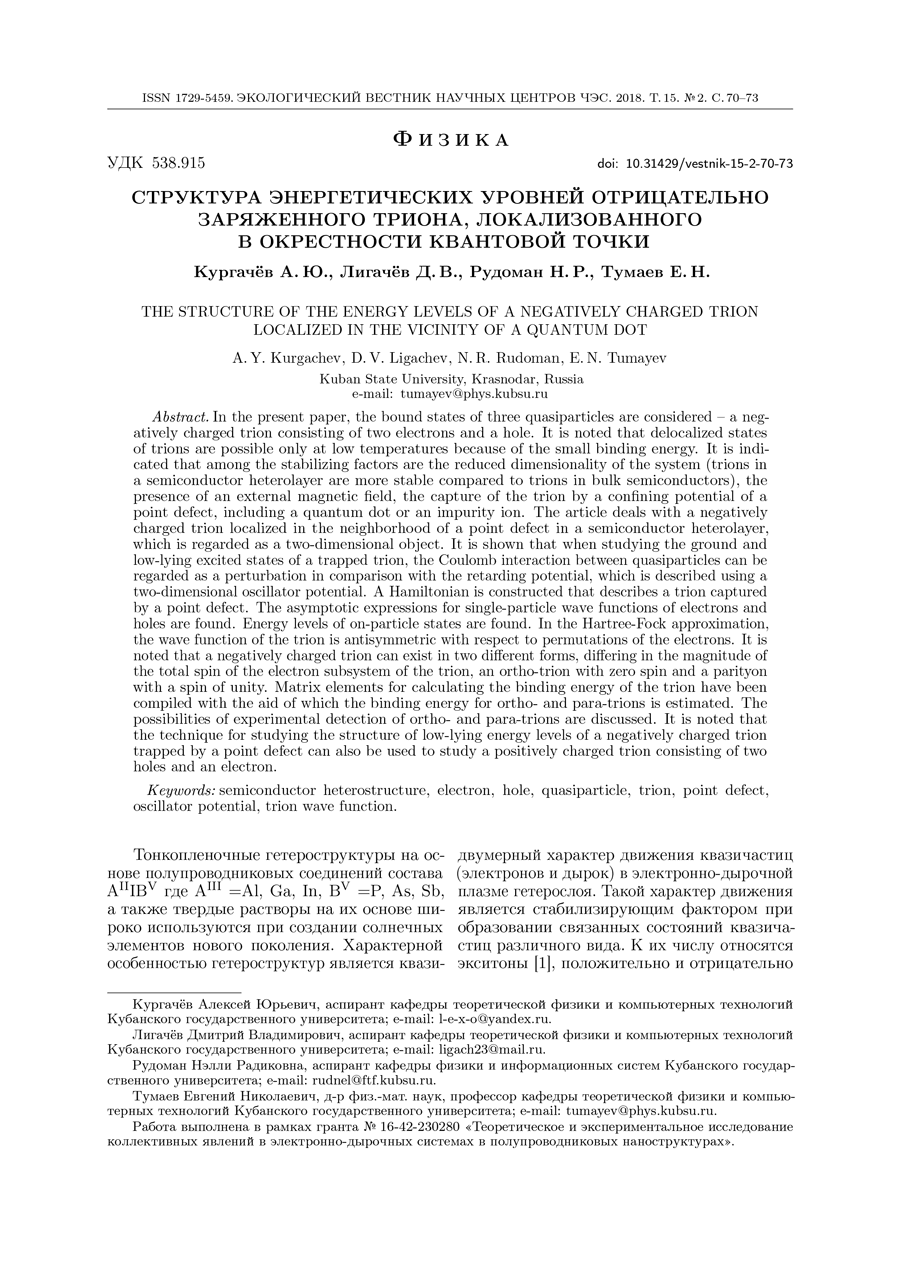The structure of the energy levels of a negatively charged trion localized in the vicinity of a quantum dot
UDC
538.915DOI:
https://doi.org/10.31429/vestnik-15-2-70-73Abstract
In the present paper, the bound states of three quasiparticles are considered – a negatively charged trion consisting of two electrons and a hole. It is noted that delocalized states of trions are possible only at low temperatures because of the small binding energy. It is indicated that among the stabilizing factors are the reduced dimensionality of the system (trions in a semiconductor heterolayer are more stable compared to trions in bulk semiconductors), the presence of an external magnetic field, the capture of the trion by a confining potential of a point defect, including a quantum dot or an impurity ion. The article deals with a negatively charged trion localized in the neighborhood of a point defect in a semiconductor heterolayer, which is regarded as a two-dimensional object. It is shown that when studying the ground and low-lying excited states of a trapped trion, the Coulomb interaction between quasiparticles can be regarded as a perturbation in comparison with the retarding potential, which is described using a two-dimensional oscillator potential. A Hamiltonian is constructed that describes a trion captured by a point defect. The asymptotic expressions for single-particle wave functions of electrons and holes are found. Energy levels of on-particle states are found. In the Hartree-Fock approximation, the wave function of the trion is antisymmetric with respect to permutations of the electrons. It is noted that a negatively charged trion can exist in two different forms, differing in the magnitude of the total spin of the electron subsystem of the trion, an ortho-trion with zero spin and a parityon with a spin of unity. Matrix elements for calculating the binding energy of the trion have been compiled with the aid of which the binding energy for ortho- and para-trions is estimated. The possibilities of experimental detection of ortho- and para-trions are discussed. It is noted that the technique for studying the structure of low-lying energy levels of a negatively charged trion trapped by a point defect can also be used to study a positively charged trion consisting of two holes and an electron.
Keywords:
semiconductor heterostructure, electron, hole, quasiparticle, trion, point defect, oscillator potential, trion wave functionAcknowledgement
References
- Davydov, A.S. Solid state theory. Nauka, Moscow, 1976. (In Russian)
- Sergeev, R.A., Suris, R.A. Energy of the ground state of X- and X+-trions in a two-dimensional quantum well with an arbitrary mass ratio. Physics of a solid, 2001, vol. 43, iss. 4, pp. 714-718. (In Russian)
- Lampert, M.A. Mobile and Immobile Effective-Mass-Particle Complexes in Nonmetallic Solids. Physical Review Letters, 1958, vol. 1, no. 12, pp. 450-453.
- Kheng, K., Cox, R.T., d' Aubigné, M.erl..Y, et al. Observation of negatively charged excitons X- in semiconductor quantum wells. Physical Review Letters, 1993, vol. 71, no. 11, pp. 1752-1756.
- Semina, M.A., Sergeev, R.A., Suris, R.A. Localization of electron-hole complexes on the fluctuations of quantum well interfaces. Physics and technology of semiconductors, 2006, iss. 11, pp. 1373-1380. (In Russian)
- Sibeldin, N.N. Electron-hole liquid in semiconductors and low-dimensional structures. Uspekhi Fizicheskikh Nauk [Successes of physical sciences], 2017, vol. 187, no. 11, pp. 1236-1270. (In Russian)
- Landau, L.D., Lifshitz, E.M. Quantum mechanics. Nonrelativistic theory. Fizmatlit, Moscow, 2016. (In Russian)
Downloads
Submitted
Published
How to Cite
Copyright (c) 2018 Kurgachev A.Yu., Ligachev D.V., Rudoman N.R., Tumayev E.N.

This work is licensed under a Creative Commons Attribution 4.0 International License.




